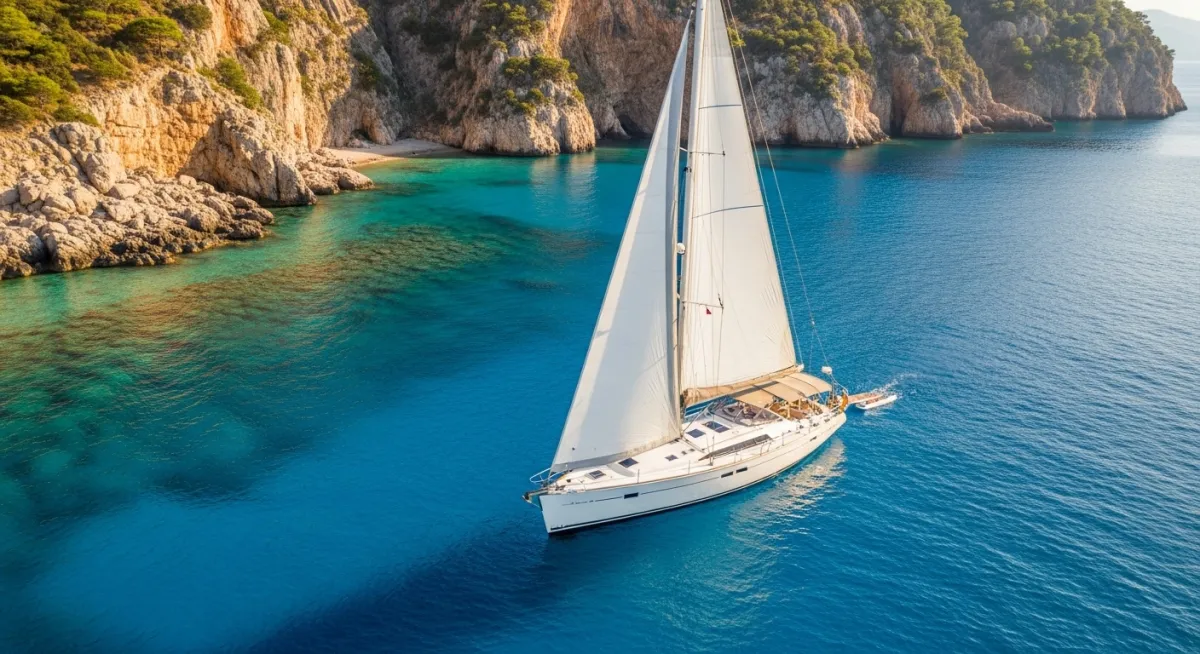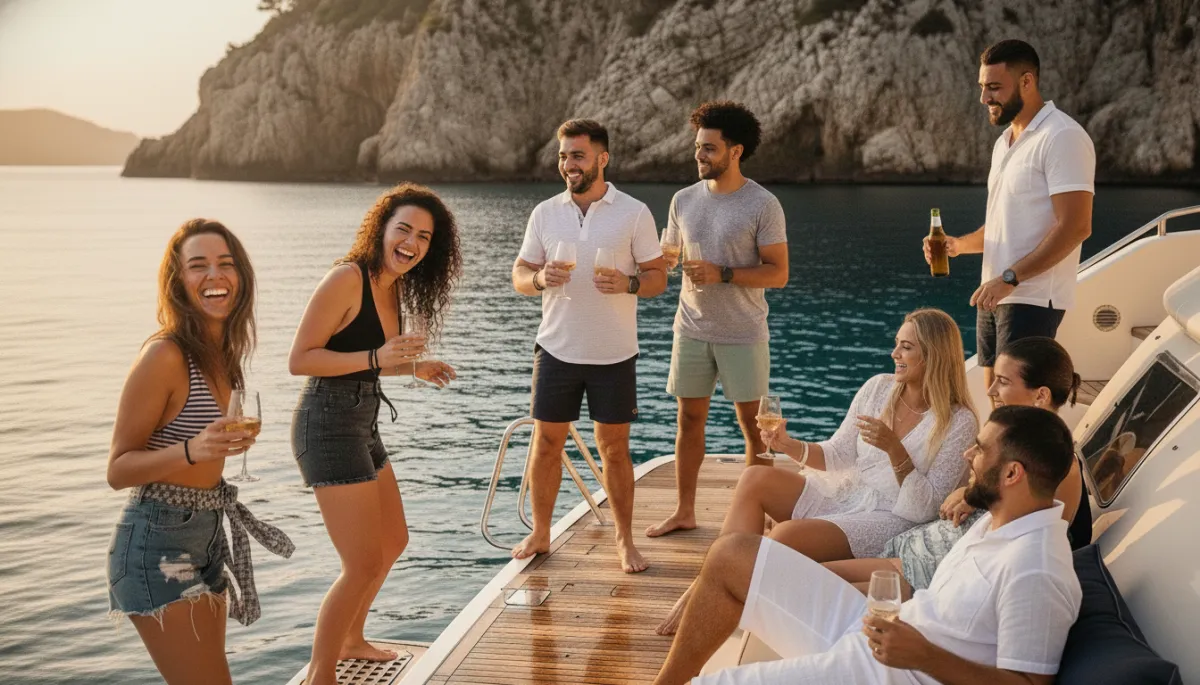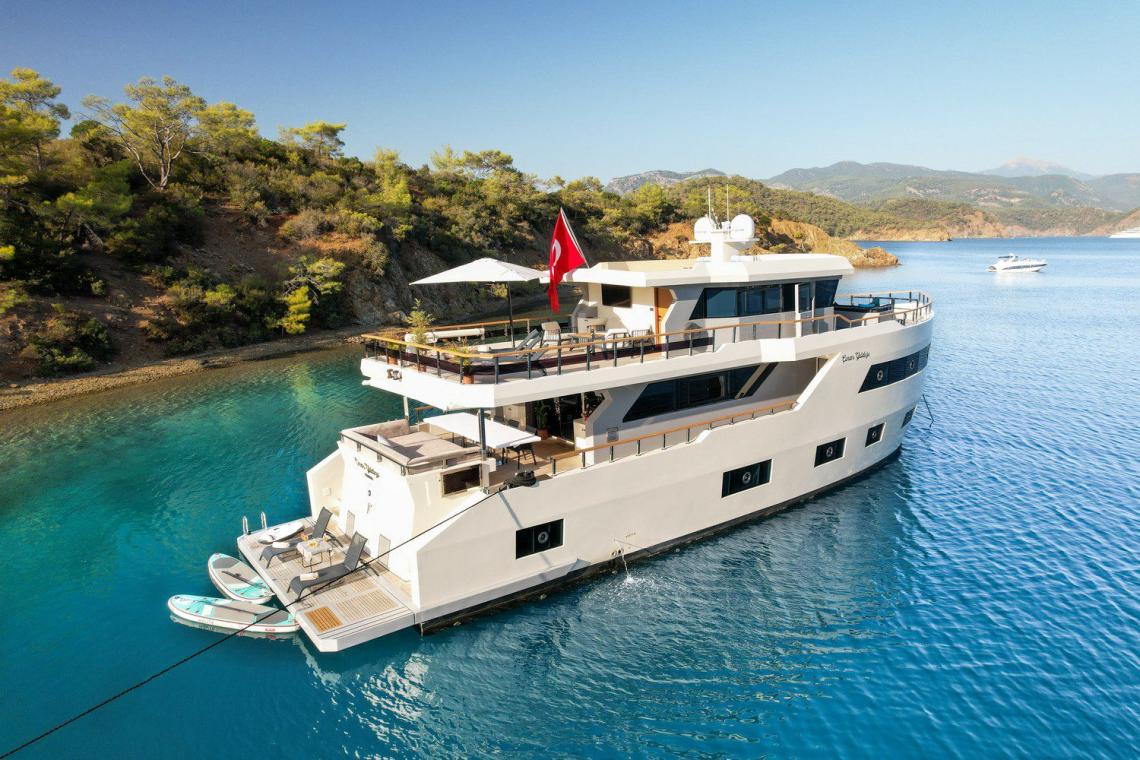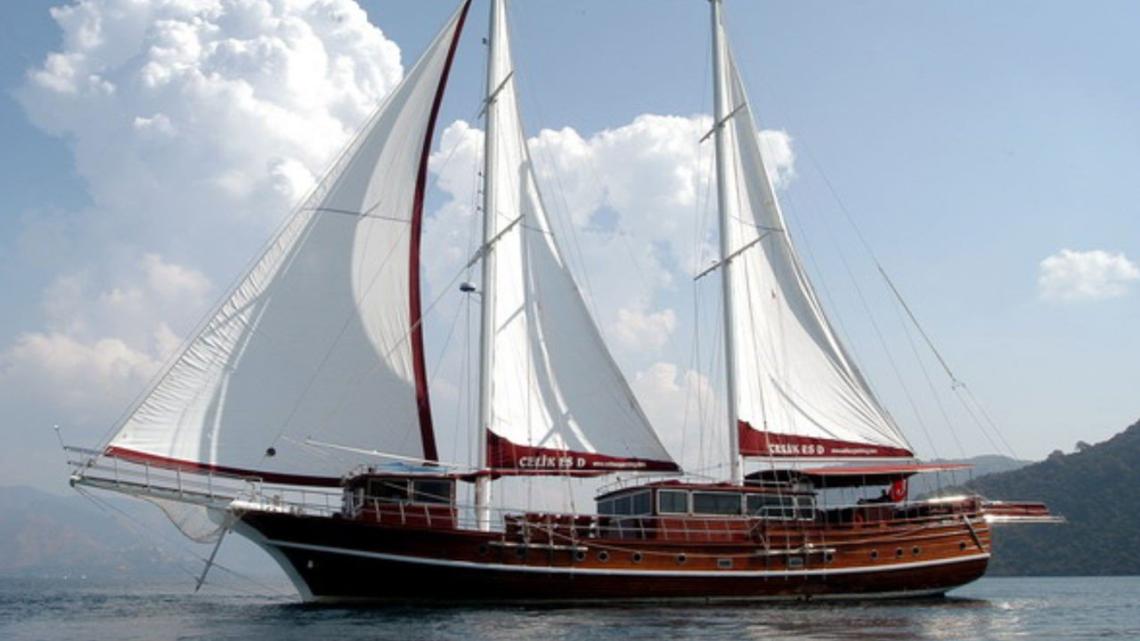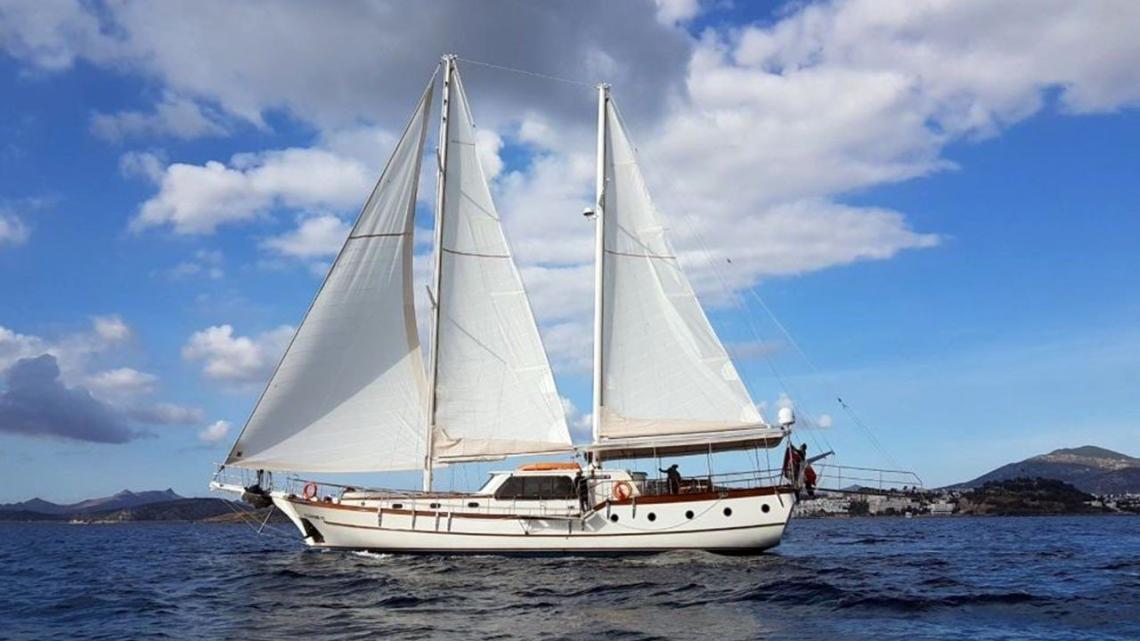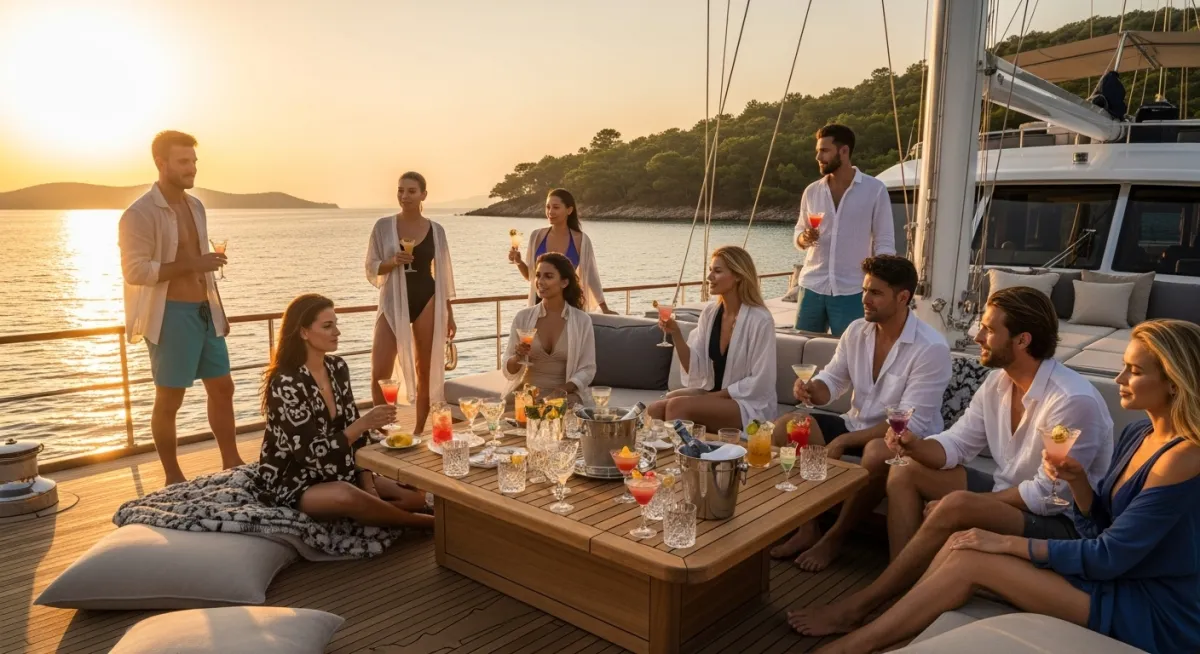
Traditional wooden vessels from Turkey's southern coast offer something modern fiberglass yachts can't match: character built into every plank. A Turkish gulet combines spacious living areas with authentic craftsmanship, typically featuring 4-8 cabins with private bathrooms, large deck space for sunbathing, and a full crew handling everything from navigation to meals. These motor-sailers mainly use engines for cruising. They also have sails that can work, but you rarely see them used during charter weeks.
Most people picture sleek white yachts when they think Mediterranean cruising. They're missing the point.
After more than 15 years of watching charter trends, families and groups often book gulet charters in Turkey. They tend to shorten their stays on modern yachts. The difference? Space, stability, and that indefinable warmth of wood and tradition.
What Makes Turkish Gulets Different
The Turkish gulet stands apart from standard charter yachts in ways that matter during your week aboard. Built in traditional shipyards along Turkey's coast — primarily Bodrum shipyard, Marmaris, and Bozburun — these wooden sailing yachts measure 18-35 meters and accommodate 8-16 guests comfortably.
Walk aboard any gulet boat and you'll notice the beam (width) immediately. Where a 24-meter motor yacht might offer 5.5-6 meters of width, a comparable private gulet stretches 6.5-7.5 meters.
That extra meter means more room in the cabins. It also creates wider walkways and deck areas. Groups can gather comfortably instead of squeezing past each other.
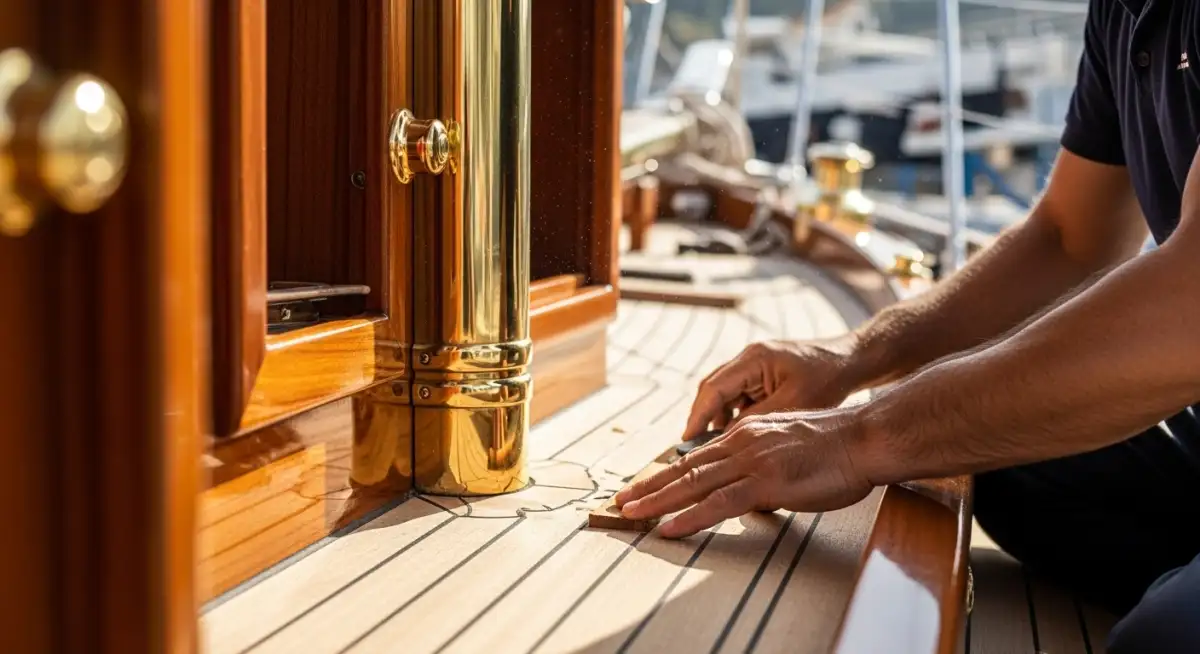
The construction matters more than most realize. Traditional wooden boat builders in Bodrum and Bozburun still use techniques passed down through generations. Pine or mahogany hulls, teak decks, and hand-finished interiors create vessels that improve with age rather than deteriorating. We've operated gulets built in the 1990s that charter better than fiberglass yachts from 2015.
Discover Gulet Charm
Get insider tips on traditional Turkish gulet charters
Recent seasons show an interesting trend. Couples under 40 often ask for modern motor yachts at first.
Then, they switch to gulets for their second charter. The reason? They remember the experience, not just the amenities.
That first charter on a sleek motor yacht photographs beautifully but feels sterile. The gulet cruise turkey delivers actual vacation.
Design Features That Work
Turkish gulets evolved specifically for Aegean sailing and Mediterranean conditions. The broad beam provides stability in the afternoon meltemi winds that kick up 15-20 knots regularly from June through September. While narrow motor yachts rock noticeably, gulets barely register the movement.
The typical layout puts cabins below deck with proper headroom (1.9-2.1 meters in quality builds) and windows or portholes for natural light. On the upper deck, there are cushioned seating areas at the front and back.
There is a dining table that can seat everyone. Sun mattresses are placed on the front deck. The stern platform sits just 30-40cm above waterline — easy swimming access without the ladder gymnastics required on taller yachts.

Sails remain functional on proper gulets, though charter captains rarely use them. The rigging and canvas cost serious money to maintain, so you'll see them unfurled maybe once per week for photographs.
The engines do the real work. They are twin diesels with 200-400 horsepower, depending on the vessel size. These engines cruise at 8-10 knots. They can cover daily distances of 15-25 nautical miles comfortably.
Gulet vs Motor Yacht: Real Comparisons
Here's what the numbers actually show for comparable vessels accommodating 8-12 guests:
| Feature | Turkish Gulet (24m) | Motor Yacht (24m) |
|---|---|---|
| Weekly Cost (High Season) | €10k–€16k | €18k–€28k |
| Beam Width | 6.5–7.5m | 5.5–6m |
| Master Cabin Size | 16–20 sqm | 12–15 sqm |
| Deck Space | 80–100 sqm | 50–65 sqm |
| Fuel Consumption | 40–60L/hour | 80–150L/hour |
| Cruising Speed | 8–10 knots | 18–25 knots |
The cost difference stems from several factors. Gulets use less fuel (40-60 liters hourly vs 80-150 for motor yachts), require less sophisticated maintenance systems, and Turkish build costs run lower than European yacht construction. A Marmaris gulet from an established yard delivers comparable comfort to Italian motor yachts costing 40-50% more weekly.
Maintenance reality: Quality gulets need annual haul-outs for hull inspection, teak deck refinishing every 3-4 years, and engine servicing every 500 hours. Budget €15k–€25k yearly for proper upkeep on a 6-cabin vessel. Motor yachts of similar size require €25k–€40k annually due to complex systems and higher parts costs.
Blue Cruise Origins and Modern Reality
The blue voyage concept started in the 1920s when Turkish writer Cevat Şakir Kabaağaçlı (known as the Fisherman of Halicarnassus) began exploring the Turkish coast by traditional wooden boat. He documented hidden coves, ancient ruins, and fishing villages that remained unreachable by road. His writings popularized "mavi yolculuk" — the blue journey — and established the gulet as the ideal vessel for coastal exploration.
That romantic origin story persists in marketing materials. Here’s what happens during your blue cruise turkey experience:
- You sail between specific anchor points.
- You swim in clear bays.
- You enjoy meals prepared by your onboard cook.
- You sleep in air-conditioned comfort. It's wonderful, but it's not wilderness adventure.
Most weekly itineraries cover 80-120 nautical miles total, visiting 5-7 different anchorages. You'll wake in a new bay each morning, spend 2-3 hours cruising to the next spot after breakfast, then anchor by early afternoon. The pattern works because it maximizes swimming time while the sun's high and allows crew to prepare lunch and dinner without rushing.
The Turkish Riviera offers different experiences depending on your starting point. Bodrum-based routes typically explore the Bodrum peninsula's northern and southern coasts, possibly reaching Greek islands like Kos with proper permits. Marmaris and Göcek departures access Göcek's famous 12 islands, the Fethiye gulf, and dramatic coastline toward Kalkan and Kaş. Each region delivers distinct character — Bodrum feels more developed and social, while Göcek and Fethiye offer more isolated anchorages.
Sample 7-Day Itinerary: Bodrum to Gulf of Gökova
Here's what a typical week looks like departing from bodrum turkey:
Day 1 (Saturday): Board in Bodrum harbor by 4pm, settle into cabins, dinner onboard. No cruising — provisioning and preparation day.
Day 2 (Sunday): Bodrum to Orak Island (12 nautical miles, 1.5 hours). Anchor by 11am in turquoise waters.
Swimming, lunch onboard. Afternoon cruise to Çökertme Bay (8nm, 1 hour). Dinner at waterfront restaurant or onboard.
Day 3 (Monday): Çökertme to Seven Islands (10nm, 1.5 hours). Explore multiple swimming spots. Lunch at anchor. Afternoon to Küfre Bay (6nm, 45 minutes). Quiet anchorage, dinner onboard under stars.
Day 4 (Tuesday): Küfre to English Harbor (8nm, 1 hour). Historical bay with Byzantine ruins. Swimming and kayaking.
Afternoon to Cleopatra Island (5nm, 40 minutes). Walk ancient ruins, swim at famous beach. Overnight at anchor.

Day 5 (Wednesday): Cleopatra Island to Karacasögüt (14nm, 2 hours). Small fishing village, last chance for provisions. Lunch onboard. Afternoon at leisure — paddleboarding, swimming. Village dinner option.
Day 6 (Thursday): Karacasögüt to Meteor Bay (16nm, 2 hours). Dramatic cliffs and clear water. Full day swimming and relaxing. Farewell dinner prepared by crew.
Day 7 (Friday): Meteor Bay to Bodrum (18nm, 2.5 hours). Morning swim, then cruise back. Arrive Bodrum by 4pm. Last night onboard in marina.
Day 8 (Saturday): Disembark after breakfast by 10am.
Total distance: Approximately 97 nautical miles. Cruising time: About 11 hours total across 7 days. This route works for first-timers — protected waters, short passages, good facilities. More experienced charterers might add Greek island stops (Kos, Kalymnos) with advance permits.
What Charter Operators Won't Mention
The traditional wooden boat construction requires constant maintenance. Quality operators handle this between charters, but budget gulets often skip critical upkeep.
You'll see the difference in details: teak decks should feel solid underfoot, not spongy. Varnish should look glossy, not cloudy or peeling. Cushions should be dry and clean, not musty.
Engine noise varies dramatically between vessels. Older gulets with poor insulation transmit diesel rumble directly into cabins. Newer builds or properly renovated classics use sound-dampening materials that reduce engine noise to barely noticeable levels. Ask about engine placement and insulation before booking — it affects sleep quality when you're anchored and running generators for air conditioning.
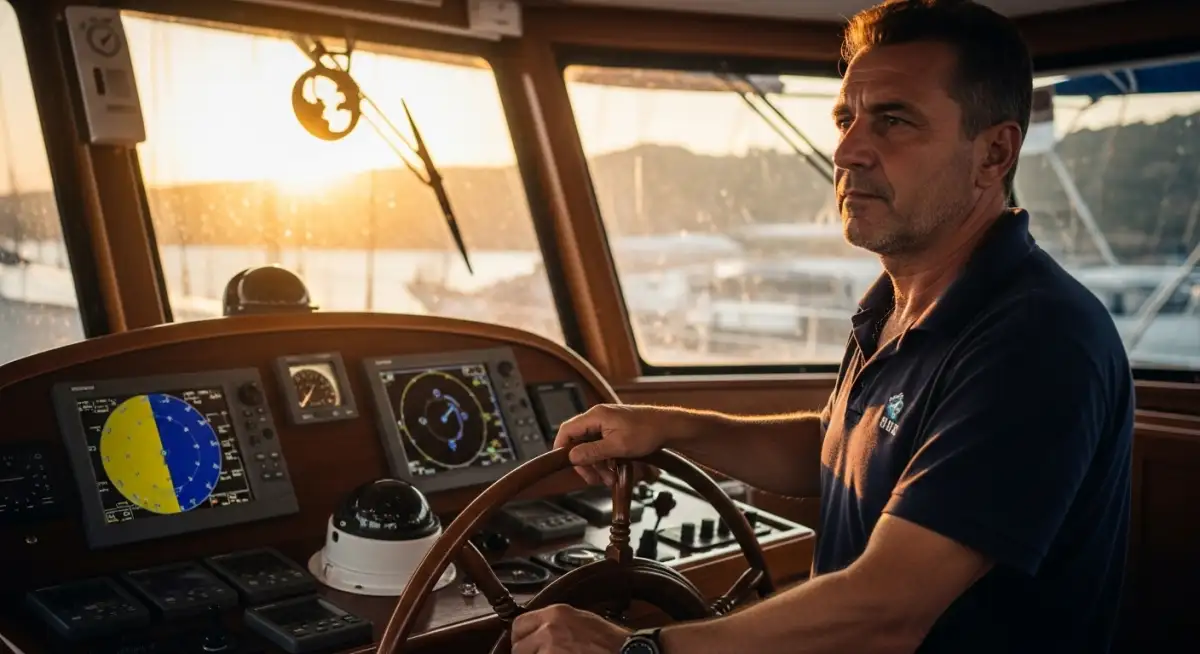
Crew quality matters more on gulets than motor yachts. Your captain, cook, and deckhand(s) live aboard with you for the week.
They're not just staff — they shape your entire experience. The best crews anticipate needs, know secret anchorages, and cook meals that rival restaurants. Poor crews do the minimum, serve repetitive food, and create awkward tension.
How to Vet Crew Quality Before Booking
Don't accept "you can't evaluate crew until aboard" as an answer. Here are 10 specific questions to ask operators:
- How long has your captain worked this specific route? Look for 5+ years experience in your chosen region — they'll know weather patterns and hidden anchorages.
- Can I see your captain's maritime license certification? Turkish commercial captains need proper licensing. Ask for certificate numbers.
- What's your cook's professional background? Best cooks trained in restaurants or hotels, not just home cooking. Ask where they worked previously.
- Can you provide sample menus from recent charters? This reveals food quality and variety. Repetitive menus signal inexperienced cooks.
- What's your crew turnover rate? Good operators retain crews for multiple seasons. High turnover (new crew every season) indicates problems.
- Can I speak with your captain before booking? Reputable operators arrange pre-charter calls. Refusal suggests issues.
- Do you have references from charters in the past 6 months? Recent references matter more than old ones. Ask for 2-3 contacts.
- How many crew members for my group size? Standard is 3 crew for 8-12 guests (captain, cook, deckhand). Larger groups need 4 crew.
- Does the same crew stay for my entire charter? Crew changes mid-week disrupt service. Confirm your crew stays aboard throughout.
- What languages does your crew speak fluently? English is essential. Additional languages (German, French) help international groups.
Red flags: Operators who can't answer these questions, refuse captain contact, or claim "all crews are similar" should be avoided. Quality operators proudly share crew credentials.
Costs and Booking Reality
High season Turkish gulet charters (July-August) run €8,000–€16,000 weekly for 4-6 cabin vessels, with luxury gulet charter options reaching €20,000–€35,000. Shoulder season (May-June, September-October) drops to €6,000–€11,000, while off-peak (April, November) can hit €4,000–€8,000. These rates typically include vessel, crew, fuel for 4 hours daily cruising, and use of water toys.
What's excluded catches people off-guard: food and beverages, harbor fees, Greek island permits (if applicable), water sports fuel, crew gratuities, and tourism taxes. Budget another €150–€250 per person weekly for the provisioning — the cook shops for groceries based on your preferences, and you reimburse actual costs plus a small service fee.
| Cost Component | High Season | Shoulder | Off-Peak |
|---|---|---|---|
| Base Charter (6-cabin) | €10k–€16k | €7k–€11k | €5k–€8k |
| Provisioning (per person) | €200–€250 | €150–€200 | €150–€200 |
| Extras & Fees | €800–€1,200 | €600–€1,000 | €500–€800 |
A crewed charter includes captain, cook, and deckhand who handle all vessel operations, meal preparation, and daily cleaning. You're never responsible for navigation, anchoring, or maintenance — just enjoying your vacation.
Here's what surprises first-timers: the base charter price represents better value than it appears. You're getting accommodation, transportation, crew service, and floating hotel combined. Compare that to renting a villa (€3,000–€5,000 weekly), plus car rental (€400–€600), plus restaurants for every meal (€100+ daily per person), plus day trip boat tours (€50–€100 per person). The gulet consolidates everything at competitive total cost.
Early booking (December-February for summer charters) typically saves 10-15% through early-bird discounts. Last-minute deals (within 30 days of departure) occasionally offer 20-30% off, but you're choosing from whatever's available rather than selecting your preferred vessel and dates.
Reading Between Marketing Lines
"Luxury gulet" means different things to different operators. Some use it for any vessel built after 2000 with air conditioning. Others reserve it for gulets with genuine luxury features: ensuite bathrooms in every cabin, separate crew quarters, premium sound systems, extensive water toys, and high-end finishes throughout.
Cabin counts can mislead. An "8-cabin gulet" might have two tiny single cabins suitable only for children or staff, plus six proper doubles. Or it might have eight genuine double cabins.
Photos rarely show cabin size honestly — they use wide-angle lenses that make 9-square-meter cabins look spacious. Ask for actual dimensions: quality double cabins measure 10–14 square meters, while master cabins reach 16–20 square meters.
Build year matters less than renovation history. A 1995 gulet fully renovated in 2020 (new engines, rewired electrical, updated bathrooms, refinished wood) outperforms a 2010 build that's received only basic maintenance. Ask specifically about major systems: when were engines serviced, when was teak replaced, when were cushions renewed.
Sailing Capability: The Honest Truth
Can Turkish gulets actually sail? Technically yes.
Practically, almost never during charters. The rigging carries real sails — typically a main sail and jib totaling 150-300 square meters of canvas depending on vessel size. In proper wind conditions (12-18 knots from favorable angles), a gulet can sail at 4-6 knots.
Charter captains avoid sailing for logical reasons. First, it's slow — motoring covers distances in half the time.
Second, it requires crew attention that could go toward guest service. Third, it limits route flexibility since you're dependent on wind direction. Fourth, and most honestly, the added wear on sails and rigging costs money operators would rather not spend.
You'll see sails raised for photographs, usually once per charter week for 20-30 minutes. Some captains will sail for an hour or two if conditions align perfectly and guests specifically request it. A few specialized sailing charter turkey operators focus on genuine sailing experiences, but they represent maybe 5% of the fleet.
The motor sailer designation accurately describes modern gulet operation. These are motor vessels with sailing capability, not sailing vessels with auxiliary engines. If sailing matters to you, book specifically with operators emphasizing it and confirm in writing that you expect actual sailing time daily. Otherwise, accept that you're on a motor yacht with traditional wooden boat character.
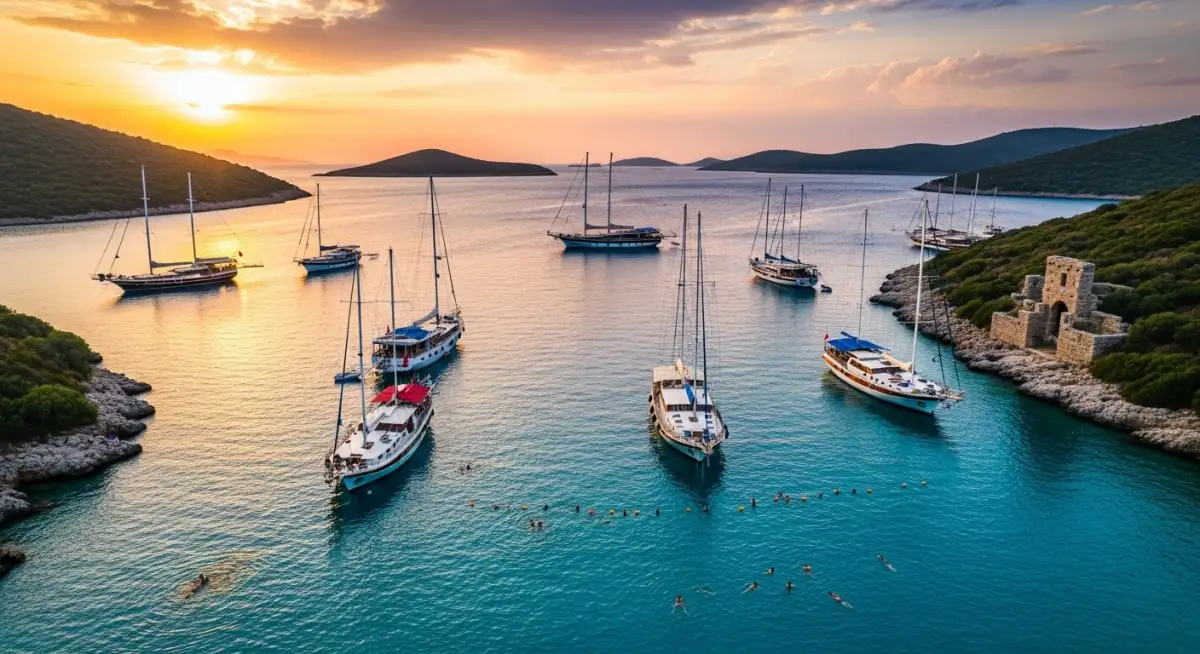
Choosing Your Gulet and Route
The bodrum gulet fleet includes everything from budget 4-cabin vessels to 35-meter luxury builds. Bodrum departures access the peninsula's protected bays — places like Orak Island, Karaada, Akbük, and Yalıkavak. The coastline offers good swimming, several ancient sites, and easy access to Greek islands (Kos, Kalymnos) if you arrange permits.
Marmaris and gocek turkey serve as gateways to Turkey's most dramatic cruising grounds. The Göcek area has many places to anchor. You can visit Bedri Rahmi Bay with its old rock paintings. Tersane Island has Byzantine ruins. Cleopatra's Bath is also nearby, along with many unnamed coves.
The Turkish coast between Göcek and Kaş offers beautiful views. Pine forests meet turquoise water, and mountains rise from the sea.
Route selection depends on priorities. History buffs should focus on Bodrum-based routes accessing Knidos, Kaunos, and Dalyan.
Beach lovers want Göcek and Fethiye for the best beaches in turkey swimming spots. Social travelers prefer Bodrum for its nightlife and marina scene. Isolation seekers should look at routes between Kaş and Kekova, where you'll anchor alone most nights.
Which Routes Work for First-Timers vs Experienced
Best for first-time charterers:
- Bodrum to Gulf of Gökova — Protected waters, short passages (8-16nm daily), good facilities at most stops. Weather predictable in summer months.
- Göcek 12 Islands — Minimal open water, countless anchorages within 5-10nm, easy navigation, beginner-friendly conditions.
- Fethiye to Kalkan — Moderate passages (12-18nm), mix of quiet bays and small towns, good balance of isolation and services.
Better for experienced charterers:
- Bodrum to Greek islands — Requires advance permits (€50–150 per person), longer passages (20-30nm), open sea crossings, customs procedures. Worth it for symi island and Kos.
- Kaş to Kekova — Remote anchorages, limited facilities, longer passages, more weather-dependent. Stunning scenery but less forgiving.
- Datça Peninsula circuit — Exposed coastlines, stronger winds, fewer protected bays. Beautiful but requires flexibility.
Seasonal considerations by route:
- June: All routes work well. Water warming up (22–24°C), wildflowers blooming, light winds.
- July–August: Stick to protected routes (Göcek, Bodrum Gulf). Meltemi winds peak at 20–25 knots afternoons. Crowded anchorages.
- September: Best overall month. Water warmest (25–27°C), winds moderate, crowds thin. All routes excellent.
- October: Experienced charterers only. Weather less predictable, some facilities closing, water cooling (21–23°C).
Greek island permits: Required for any Turkish-flagged vessel visiting Greek waters. Cost €50–150 per person depending on islands visited. Process takes 7-10 days minimum. Your operator handles paperwork but needs passenger passport copies 3 weeks before departure.
Popular stops: Kos (1 hour from Bodrum), symi island (2 hours from Marmaris), Rhodes (3 hours from Marmaris). Weather permitting — captains cancel Greek crossings if winds exceed 20 knots.
Family Groups and Specific Needs
Family groups need specific features: swim platforms with easy water access, kayaks and paddleboards included, cabins large enough that kids aren't cramped, and crew experienced with children. The best family yacht charter experiences happen on 6-8 cabin gulets where kids can spread out and parents get some space.
Look for gulets with:
- Shallow swim platforms (30–40cm above waterline) — toddlers and non-swimmers access easily
- Mesh safety netting on deck railings — prevents small children from slipping through
- Separate crew quarters — ensures family privacy throughout vessel
- Water toys included — kayaks, paddleboards, snorkel gear, inflatable toys (not charged extra)
- Flexible meal times — crew accommodates children's eating schedules
Age-appropriate routes: Families with children under 8 should choose protected routes (Göcek 12 Islands, Bodrum Gulf) with short passages and calm waters. Teenagers handle longer passages and more adventurous routes (Greek islands, Kekova region). Mixed-age groups work best on moderate routes (Fethiye to Kalkan) offering variety.
Timing Your Charter
Peak season (July-August) brings guaranteed sunshine, warm water (26–28°C), and crowded anchorages. You'll share popular bays with 5-10 other gulets. Harbor fees increase, and restaurants raise
References
- Turkish Ministry of Culture and Tourism - "Blue Voyage: Turkish Riviera" https://turkishriviera.goturkiye.com/blue-voyage
- Wikipedia - "Blue Cruise: Traditional Turkish Voyages" https://en.wikipedia.org/wiki/Blue_Cruise
- Wikipedia - "Gulet: Traditional Turkish Wooden Sailing Vessels" https://en.wikipedia.org/wiki/Gulet
- Lonely Planet - "12 Unmissable Things to Do in Türkiye" https://www.lonelyplanet.com/articles/top-things-to-do-in-turkey
- CNN Travel - "Why Turkish gulets are the way to sail the Aegean" https://www.cnn.com/2025/07/15/travel/video/gulet-yacht-turkey-sailing-spc-vrtc







